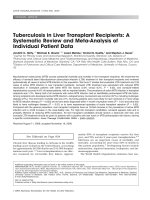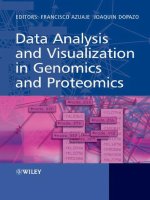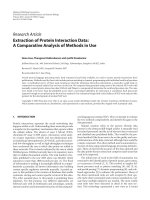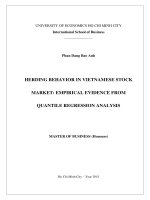Regression analysis explained Experience in Data Science Mentored
Bạn đang xem bản rút gọn của tài liệu. Xem và tải ngay bản đầy đủ của tài liệu tại đây (432.27 KB, 18 trang )
MD Arshad Ahmad
15 Years+ Experience in Data Science
Mentored 100+ people
Agenda
• Introduction to Regression Analysis
– What is Regression Analysis
– Why do we need Regression Analysis in Business –
Introduction to Modeling
• Introduction to OLS Regression
• Introduction to Modeling Process
2
What is Regression Analysis?
Regression Analysis captures the relationship between one or more response variables
(dependent/predicted variable – denoted by Y) and the its predictor variables
(independent/explanatory variables – denoted by X) using historical observations of
both.
Hence its estimates the functional relationship between a set of independent variables
X1, X2, …, Xp with the response variable Y which estimate of the functional form best
fits the historical data.
Y = f (X1, X2,.., Xp) + Є
where Є denotes the “Residual” or unexplained part of Y
Historical
Data
Statistical
Analyses
Predict Future
Events
Bad
od
Go
PredictiveMetr
ics
Scores
ABC Corp = 100
XYZ Corp = 71
JKL Corp = 45
DEF Corp = 23
Your
Company
3
Types of Regression Analysis
Y = f (X1, X2,.., Xp) + Є
There are various kinds of Regressions based on the nature of : • the functional form of the relationship
• the residual
• the dependent variable
• the independent variables
Functional Form
Residual
Dependent Var
Independent Var
▪ Linear
▪ Non-Linear – Out
▪ Based on the
distribution of the
residual – normal,
binomial, poisson,
exponential
▪ Single
▪ Continuous
▪ Discrete
▪ Binary
▪ Multiple – Out of
▪ Numerical
▪ Discrete
▪ Continuous
▪ Categorical
▪ Ordinal
▪ Nominal
of scope for this
presentation
scope for this
presentation
Types of Linear Regression
Dependent Variable Type
Residual Distribution
Types of Regression
Continuous
Normal (with constant
variance)
Ordinary Least Squares
(OLS)
Continuous
Normal (without constant
variance)
Generalized Least Square
Binary
Binomial
Logistic Regression
Discrete
Poisson
Poisson Regression
Rational
Exponential Family of
Distributions
Generalized Least Squares
5
Other Types of Regression Related Techniques
•
Simultaneous Equation Models
– When both X & Y are dependent on each other
•
Structural Equation Modeling / Pathways
– Captures the inter-relations between Xs i.e. captures
how Xs affect each other before affecting Y
•
Survival Analysis
– Predicts a decay curve for a probability of an event
•
Hierarchal Bayesian
– Estimates a non-linear equation
6
Agenda
• Introduction to Regression Analysis
– What is Regression Analysis
– Why do we need Regression Analysis in Business –
Introduction to Modeling
• Introduction to OLS Regression
• Introduction to Modeling Process
7
What is Modeling?
✔
Is based on Regression Analysis
✔
It can be used for the following two distinct but related
purposes
✔
Predict certain events
✔
Identify the drivers of certain events based on some
explanatory variables
✔
Isolates individual effects and then quantifies the
magnitude of that driver to its impact on the dependent
variable
✔
It is required because
✔
Knowledge of Y is crucial for decision making but is
not deterministic
✔
X is available at the time of decision making and is
related to Y
Volume = Base Sales + b2(GRPs) + b3(Dist) … + bn(Price)
Example of Modeling in Business
▪
Predict the sales that a customer would contribute, given a certain set of attributes
like demographic information, credit history, prior purchase behavior, etc.
▪
Predict the probability of response from a direct mail thus saving cost and acquire
potential customers.
▪
Identify high responsive and high profit segments and targeting only these
segments for direct mail campaigns
▪
Identify the most effective marketing levers & quantify their impact
▪
To find out what differentiates between buyers and non buyers based on their past
3 months usage of the product and the age group
Agenda
• Introduction to Regression Analysis
• Introduction to OLS Regression
• Introduction to Modeling Process
10
Introduction to Ordinary Least Squares
Dependent Variable Type
Residual Distribution
Types of Regression
Continuous
Normal (with
constant variance)
Ordinary Least
Squares (OLS)
Continuous
Normal (without constant variance)
Generalized Least Square
Binary
Binomial
Logistic Regression
Discrete
Poisson
Poisson Regression
Rational
Exponential Family of Distributions
Generalized Least Squares
11
Introduction to Ordinary Least Squares – Simple Regression
Advertising
$120
$160
$205
$210
$225
$230
$290
$315
$375
$390
$440
$475
$490
$550
Sales
$1,503
$1,755
$2,971
$1,682
$3,497
$1,998
$4,528
$2,937
$3,622
$4,402
$3,844
$4,470
$5,492
$4,398
Goal: characterize relationship between
advertising and sales
12
Introduction to Ordinary Least Squares – Simple Regression
Result: equation that
predicts sales dollars based
on advertising dollars spent
Sales = B0 + B1*Adv.
Minimizes Error sum of squares ,Hence the name
“Ordinary Least Square Regression”
13
Introduction to Ordinary Least Squares – Multiple Regression
• Credit card balances
– payment amount
– years
– gender (0/1)
• Minimizes squared error
in N-dimensional space
Balances = 2.1774 +.0966*Payment + 1.2494*Months + .4412*Gender
14
OLS Model Assumptions
1.
Linearity
Model is linear in parameters
2.
Spherical Errors
Error distribution is Normal with mean 0 &
constant variance
3.
Variance(ei)=constant for all i
Non-Autocorrelation
The errors are statistically independent
from one another. This implies the data is
a random sample of the population
6.
E(ei)=0 for all i
Homoskedasticity
The errors have constant variance
5.
ei ~ Normal(0, σ2)
Zero Expected Error
The expected value (or mean) of the errors
is always zero
4.
Yi=a+b1X1i+b2X2i+…+bpXpi+ei
corr(ei, ej)=0 for all i≠j
Non-Multicollinearity
The independent variables are not
collinear
Covariance (Xi, Xj) = 0
Steps in OLS Regression
Assume all OLS assumptions hold
Run regression in software (R/Python)
Check if assumptions really hold
Check if Fit is good
Check Hypothesis testing results
i.e. variable significance
Iterate to make “BEST” model
Applications of OLS Regression in Business
Sales
Prediction
Models
Marketing
Effectiveness
Models
Ad.
Effectiveness
Models
Profitability
Models
Just a few of
them
Capital
Expenditure
Model
Claims
Forecasting
Models
Chare-off
Prediction
Models
Macro
Economic
Models
17
Thank You!
To know more Get In Touch!
Kick start your Data Science Career
Book Mentoring Session
www.decodingdatascience.com









